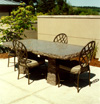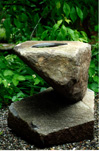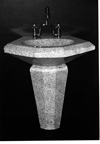This interview with Lloyd Whannell was a pleasure to write; the conversations took place via email and in person at Camp Brotherhood this past July. For those of you unfamiliar with Lloyd as a carver— the sight of his dusty face, bandana in place around his hair, his brilliant blue eyes and his warm smile, this interview will be an opportunity to learn about his artistic persona and his enthusiasm about his art. Lloyd also talks with us about his duties as President of the NWSSA and some of his hopes for its future.
SS: Hi Lloyd. Let’s start with what really interests all of us, your history as an artist, your beginnings in artistic pursuits.
LW: I came to stone sculpting from working in clay. About 12 years ago I realized that I needed some form of artistic expression in my life, so I went back to school, taking classes in drawing and architectural history at the University of Washington. That led me to pottery and clay figure sculpting, which led me to stone sculpting. I did some figurative clay sculpting classes here on the island with Jan Brown, and she introduced me to the NWSSA through the Whidbey workshop. That’s how I began with the NWSSA.
In many ways I don’t really consider myself an artist. I think of myself as someone who makes beautiful things. Philosophically I don’t really think about it. Being an “artist” does come into play in my thought process. I like to make simple, elegant and beautiful pieces in stone that please me, which is really all that matters.
SS: We’ll get into the workings of NWSSA and your role on the board a little further on. Let’s talk a little about your sculpture, the work that you do every day.
LW: My stone work is a combination of functional pieces like vanity sinks, patio tables, outdoor water basins for the garden, and figurative sculptures. I started out making small garden basins, and I seem to be drawn to the vessel as an elemental expression of stone in an outdoor environment. I just keep combining shapes and stones, and each one leads me to the next. It’s a similar experience for my stone sinks. Each one I make gives me multiple ideas for more. They are a wonderful venue for theme and variation. I also find that working with clients keeps me expanding my possibilities. I have had clients request a certain type of stone or shape that I may not have tried on my own, but they turn out to be beautiful and there’s another direction for me to explore.
SS: What are you working on right now that you’d like to share with us?
LW: My latest piece is a powder room countertop with a bowl carved in. It’s a beautiful Cambrian black granite 6’ x 2’ x 8” thick with a broken front face, a beveled top and front edge, and it has a 16” x 24” elliptical bowl, with the drain offset towards the back of the bowl. I mark out grids and do constant measurements, but in the end I just have to rely on how my eye responds to the shape. The eye always has the last say. I also find that I enjoy the challenges that come with working in large stone like this. This piece weighs probably around 1500 pounds, and now I have to figure out how I’m going to get it to its final home.
SS: Are you working exclusively on this piece until it’s completed or are you also working on something else?
LW: No, I often work on several pieces at once. Another piece I’m working on is a figurative sculpture. For the last two years I’ve started a figurative piece at Camp Brotherhood, then barely managed to finish it at home before the next year’s symposium. This year I’ve managed to finish early and have started a second one that I hope to have finished before July. Instead of the female torso form in marble I’ve been doing, I decided I wanted to try drapery, so this is a kneeling figure fully robed and hooded, with only the face showing, in Indiana limestone.
SS: It seems like a big contrast in form, from the functional pieces to a sculptural piece. Does this contrast affect your work? 
LW: Well, whenever I start to feel too cocky about how easy my functional pieces seem to be getting, I start working on a figurative piece. Humbleness follows very quickly. What draws me to the figure is how much I see there is to learn. When I’m working on a functional piece I keep rough track of the time I spend, but on the figurative pieces I just sculpt, and it’s a wonderful change of pace, but it’s also my biggest physical challenge. Sometimes a bird flies by and catches my attention or the light changes and then I pause and realize hours have passed. Only then do I realize my arms hurt, my back aches, I’m hungry and it’s almost dark, but, there’s a big grin on my face.
SS: The figurative work seems to really affect your mental outlook. Is this a balance that works well in keeping motivated?
LW: To maintain my physical and mental balance I try to have one figurative piece and several functional pieces going at the same time. If I have a piece that needs many hours of shaping with the grinder, or is at the polishing stage, I try to spread it out over as many days as possible. A little figurative air hammer work, some pitching to rough out a new piece, some polishing, a little final hand sanding, all interspersed with garden weeding and tea breaks keeps my body from complaining too much. And the one tool that I prize above all others, the one I couldn’t live without, is my hot tub.
As for other influences, I would say that the Asian influence is predominant in my functional work. There is a simple elegance in a natural piece. This really appeals to me. Now, with figurative work, European traditional work (i.e., Italian pieces) are influencing me. I really need to think and process it. I need to do as realistic a form as possible before doing abstract work. Female torsos really intrigue me and I could do it forever now that I’ve done it. The flow of fabric on the torso, the drapery effect, that is really interesting me now and I am exploring this form in my sculptures. With each piece that I work I then begin to see 10 more pieces out of it - the variations are appealing to me. So as I work I influence myself to pursue other variations of the form. Because of the visions I have, that come rather easily, of more forms, more creations, I don’t understand other artists who don’t know what to do with the stone. I have people who assist me and I could keep them busy forever because I have no lack of ideas, just a lack of time.
SS: How do you market your work, does the functional work constitute a majority of your work? Does it allow you an opportunity to market your other sculptures?
LW: Showing my functional work has been an ongoing challenge. My main outlet is an interior design store here on Whidbey Island with a great clientele. Most of my commissions and sales come through there. I’ve been a contractor, building homes, for about 20 years. Now my time is split, with the contracting work accounting for about 60% of my working time, and I have developed contacts with architects and designers to whom I also do direct mailings for my functional stone work. I have found galleries reluctant to take on functional work although the winds seem to be shifting slowly. Most of my work now is private commissions for individuals. I only have time to work on pre-commission work now. Hopefully someday I’ll start a web page, which I think is a great way to get your work seen, especially functional work.
SS: Any other “hopefully someday” thoughts you would like to share?
LW: I have wild ideas. I would love to experiment with new ways of cutting stone. Small, easy to use hand held water jets or lasers that can sculpt stone like hot knives cutting through butter. Maybe sound waves or electrical charges that separate the crystals to split granite. A well-balanced light saber might work well on stone. All I would need is a wild, crazy technical staff and an unlimited budget. Anyone out there?
SS: Let’s “tool talk” for a moment...I imagine that because of your contracting and building experience you are a tool man?
LW: Yes, because of the building work, the usual power tools, including saws, etc., are a breeze for me and I am familiar with their uses. The tools I use for sculpture include hand chisels and hammers, air chisels, 7” saw, 16” saw, grinders, polishers, core drill, roto-hammer drill, acetylene torch, 700 lb. capacity scissor lift table cart, engine hoist lift, and a 1948 5000 lb. capacity forklift. 
SS: Any teachers that you’ve had that have helped in your sculptures, anyone whose work you’ve admired that has affected you?
LW: The vast amount of knowledge that is available at all the symposiums is just too much to much to itemize in a short list. It all adds into the motivation, the method and inspiration for the work. I appreciate the classes I have taken from Sabah (Al-Dhaher) and Alfonso (Rodriguez Medina) which have greatly helped me and working with them and taking their classes have impacted my work. I greatly admire the work of a local Washington artist, Vasily Fedorouk.
SS: You mentioned that about 60% of your time is devoted to your contracting and building business. Could you estimate how much you are able to complete, with regard to your sculpture, in the other 40% of your time?
LW: I complete one or two figurative pieces each year and four or five carved sinks, maybe a patio table and eight to 10 outdoor basins.
SS: And of course, there’s also that “other” sculpture work. The business of the association that you manage to fit into your busy schedule. Let’s start with how you got started with the organization and working with the board.
LW: My present position, as president, really started as a progression six years ago when I started getting involved with NWSSA. Jan Brown had introduced me to the Whidbey Island symposium, then after about three years, when Jan left the island, I assumed leadership of the Whidbey Island symposium for several years, which introduced me to the organizational aspect of NWSSA. Then at Camp B, during my third year as a member, I was asked to run for the board. I have been on the board now for three years, becoming president last year. I am now into the middle of my second year as president, which term will end on January 1st. I then have one more year on the board.
SS: What are your duties as President of NWSSA?
LW: Running the board meetings and keeping a pulse on the organization as a whole. Our membership is very spread out and keeping all things well ordered takes time, connecting people, maintaining clear communications, coordinating efforts of the membership. There is a fair amount of delegation of duties and keeping track of progress. I also must watch out for the business elements so we can get together and enjoy sculpting. There are matters involving insurance, legal, and financial work — the business part of making sure the organization’s needs are being addressed and the business of NWSSA, as an entity that encompasses all the many events and symposiums, is running smoothly. It’s really easy work for me to do because I’m left brained!
SS: What determines how long you remain as president and how long you remain on the board?
LW: There are elections for the board positions and the officers. Board members are elected to a two-year term, and the officers are elected to one term. I was elected to the board for two years, becoming President my second year. I then was elected to the board for another two-year term, and President for another year. So while I remain on the board for another year, my term as president will be up in January ... And yes, I am looking forward to seeing someone else take over the position and carry forward with the work.
SS: What is involved in working in the business of NWSSA — how could someone who is interested in working on or with the Board get involved? What is required?
LW: We need people with time. It’s that easy. We have people in our membership with specific expertise in certain areas that could be valuable to the association. And when members with expertise in specific areas volunteer their time it’s that much easier for the jobs to get accomplished. I would love it if we could tap into the day job experience that we have available among our members. However, even without expertise in a business sense, there are members with expertise in computers, marketing, advertising, communications, the list goes on. We have volunteers with no expertise in anything specific but just a willingness to participate, and that’s just as valuable.
The association has gotten a good response from volunteers at Camp Brotherhood, for instance. We will follow through and contact these members to make sure that they are involved and we can find jobs that they feel comfortable assuming. The members also should also follow through if they are interested in volunteering — not just for a specific symposium, but for any other events or for work with the board. They should contact any one of the board members we have now, or myself, and share what experience or expertise they have, or what time they have available. What most members who attend, for instance, just one symposium, don’t realize is that we have a constant flux of needs from year to year. There’s a constant need for help. We need help now for next year’s job.
SS: Do you have any plans to help integrate volunteers into positions they could assume?
LW: I would love to see a mentor system started. We would have members volunteer a little time to learn the job first and then step into it. So we’re not reinventing the wheel each time. So we need to make it a gradual process — gradually stepping up to more responsibility. Someone new this year volunteering could possibly become President within three to four years. You need knowledge of the people involved and the group as a whole. A lot of people are busy and we all have lives and I understand that. I’d rather have people who say “I don’t have time now” but might consider the longer term - “I can next year”. But this really depends on the members and people stepping up to the plate to volunteer their time, and make a commitment and follow through. It’s just that simple to get involved. And I welcome even first year members who might have just discovered us through a symposia this past summer. Please feel free to call and volunteer your time and find out what is available for you to do.
SS: What about the costs of being a volunteer, are there any?
LW: It doesn’t have to cost anything. We have travel expenses and other costs that are covered for business expenses on behalf of the association. To be truthful, most of these expenses are minimal and most of the members we have had on the board have covered their own expenses. However, there really is very little expense. We have people in many different parts of the country who have volunteered and with today’s technology - from email to faxes, a lot is accomplished with very little.
SS: Lloyd, you probably have your fingers on the pulse of this association more than anyone else, so could you tell me, what does our future hold in store?
LW: This organization is growing into a wonderful resource for sculptors, not just in the Washington and Pacific Northwest region. We have members from all over the US, many who volunteer their time, whether planning symposia, writing for the newsletter, or marketing the events we sponsor. Ideas are beautiful but it’s the work that gets it done. We are now making that leap into the international community and we need our members to help ensure that we continue this growth. We always have a place in our organization for much more participation from our members and their efforts...they just have to make their desires known. As an organization we have grown to a point where we have potential for major leaps. I’m excited about the events we have planned in the next year, and looking forward to hearing from more of our members who want to participate in our growth.
SS: Thank you, Lloyd, for taking the time to share so much. If you would like to contact Lloyd, he can be reached via email at This email address is being protected from spambots. You need JavaScript enabled to view it. or at 360-579-1995

